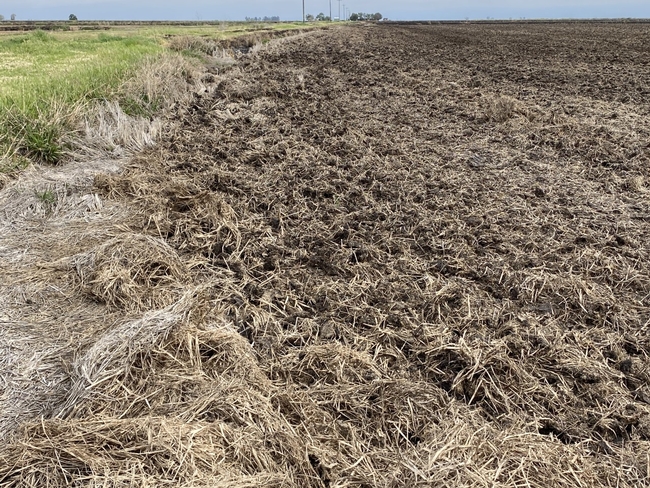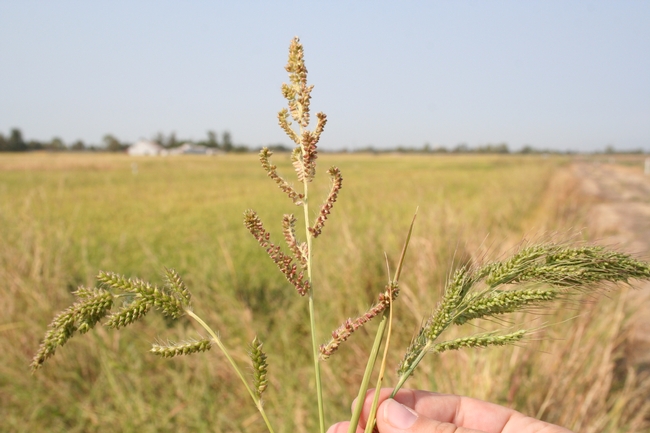- Author: Bruce A Linquist
- Editor: Consuelo Baez Vega
Last year roughly half of the rice acreage was left fallow. We have been conducting research (funded by the Rice Research Board) looking at the differences between rice grown after a fallow versus rice grown following rice. We have found that rice following a fallow has higher yield potential. In our two years of study we saw about a 2 to 3 sack yield advantage in rice after a fallow. Higher yields may be due to reduced disease incidence. In both years of the study we saw lower incidence of stem rot in rice following a fallow year. As mentioned, this can lead to higher yields but also to less lodging.
Regarding nitrogen management, we used a labeled nitrogen fertilizer to allow us to determine if the nitrogen in the plant came from fertilizer or from the soil. We found that fertilizer N was used similarly when rice followed a fallow or when it followed rice. Interestingly, we also found that when rice followed fallow, more nitrogen was available from the soil – particularly after PI. This has a couple of implications. First, it means if you had a fallow rice field last year, you may be able to back off on your overall N rate. In our data from one year, we found that you could back off by up 20 to 30 lb N/ac. Secondly, most of the additional N availability came after PI. This suggests that if you are routinely topdressing, it may not be necessary when rice is following a fallow year. Regardless, I would still suggest monitoring the crop at PI using a Leaf Color Chart or a GreenSeeker to make a more informed decision about N management.
Some of you may be asking “why do we get more nitrogen in a field that was fallowed?”. This is a great question. In fields that have been in rice where the rice straw is incorporated and flooded during the winter, phenols accumulate. Phenols are an organic compound that tend to build up when organic matter, such as straw, decomposes under anaerobic conditions. Given how most farmers manage their straw we would expect a build up of phenols. In fact, we have looked at soils around the valley and have found this to be the case. Phenols also bind nitrogen, making it unavailable for plants. Imposing long periods of time when the soil is aerobic such as during a fallow period, promotes the breakdown of these phenols and the release of nitrogen.
- Author: Bruce A Linquist
- Editor: Consuelo Baez Vega
As I write in late March, no one is out in the fields yet. It is too wet. This suggests that planting will be later than normal. On a positive note, I did see that NOAA has forecast a drier than normal April. Anyways, with this I would like to suggest some thoughts for planning.
First, from our Yield Contest data, we have seen that it is really important to ensure good stand establishment. In late years, it is easy to get in a rush and skip steps. While this may be necessary, make sure you do your best to get a good stand. You want an evenly spaced 25 established plants per square foot.
Second, a late planting will probably mean a later harvest. With late harvests, one risks fall rains which can further delay harvest and reduce grain quality. On your late fields, think about planting earlier maturing varieties such as M105, M-206 and M-210. These varieties have good yield potential but are about 5-7 days earlier (more in the southern part of valley) the M-209 or M-211. These longer duration varieties should be planted in earlier fields if possible.
Third, do not over fertilize with nitrogen as this can further delay harvest. For more on this, see the other topic I have written on for this newsletter.

- Author: Consuelo Baez Vega
There are many organizations and programs that provide free funding assistance for growers, which can get overwhelming with where to look and who to talk to. In an effort to assist growers with these questions a list of grants has been made to compile those that are currently available. Don't miss out if you qualify!
Organic Production grants
Organization: CCOF
Bricmont Hardship Assistance Fund
Deadline: May 12, 2023
- Note: applications open April 12, 2023
$5,000 maximum
Grant available to organic producers who experienced losses due to natural disasters, personal hardship, or other unexpected emergencies.
Requirements (from CCOF):
- Be a certified organic producer in good standing
- Provide a valid organic certificate from any accredited certifier
- Submit a complete description of hardship endured within the last 12 months along with supporting financial documentation of economic loss
- Must be based in the United States
- If awarded, agree to submit a final progress report
- Grant funds cannot be used for organic certification fees
Priority is given to first time applicants and undeserved producers.
More information: https://www.ccof.org/page/hardship-assistance
Contact: lhernandez@ccof.org
Conservation related grants
Organization: NRCS
Environmental Quality Incentives Program (EQIP)
Deadline: Applications accepted year round
Amount not specified
Provide technical and financial assistance to growers and forest landowners to undertake natural resource concerns.
Example:
- Water and air quality improvement
- Water conservation
- Soil health improvement
- improving/ creating wildlife habitat
- And others…
Work with applicants one-on-one to develop a conservation plan based on the applicant's conservation goals and vision as well as providing assistance with the application process.
Apply at a local USDA Service Center.
More information: https://www.nrcs.usda.gov/sites/default/files/2022-10/EQIP-fact-sheet.pdf
Contact: Local NRCS office
Emergency/ uninsured grants
Organization: USDA
Pandemic Assistance Revenue Program (PARP)
Deadline: June 2, 2023
Up to $125,000 receivable
Direct financial assistance for growers affected by the COVID-19 who produced at least during a part of 2020 and had minimum 15% loss in allowable gross revenue.
- Compared to 2018-19 year or expected 2020 allowable gross revenue (if no 2018-19 year production)
- Payment determined per applicant
More information: https://www.farmers.gov/sites/default/files/documents/farmersgov-parp-factsheet.pdf
Contact: Local FSA office or USDA employee 1(877)-508-8364
Organization: CCOF
Drought Relief Grants for Producers in California
Deadline: May 12, 2023
- Note: applications open April 12, 2023
$5,000 to $20,000 range amount
Reimbursements for drought incurred expenses.
Examples:
- “Increased electric utility bills of 50 percent or more due to increased electricity rates”
- “Decreased crop yields/crop loss due to less water available or having to fallow land” etc
Qualification: Must be small-scale CA grower and socially disadvantaged (Description of social disadvantage based on CDFA's farmer equity report*)
**CDFA definition of socially disadvantaged groups: “AB 1348 states that a socially disadvantaged farmer or rancher is a farmer or rancher who is a member of a socially disadvantaged group. A “socially disadvantaged group” means a group whose members have been subjected to racial, ethnic, or gender discrimination. These groups include the following: African Americans, American Indians, Alaskan Natives, Hispanics, Asian Americans, Native Hawaiians and Pacific Islanders, Female farmers and ranchers of color.”
Not eligible if the grower received a CDFA CUSP within the last 12 months.
More information: https://www.ccof.org/page/hardship-assistance
Contact: lhernandez@ccof.org
- Author: Luis Espino
2023 Rice Production Workshop
An in-depth workshop that covers the principles and practices of rice production in California
March 15 and 16, 2023
8:30 am - 3:30 pm
Lundberg Family Farms
5311 Midway, Richvale, CA 95974
Cost: $200
DPR, CCA, and CDFA N management continuing education credits requested

- Author: Luis Espino
2023 RICE GROWER MEETINGS
Woodland: Monday, January 23, 9:00 am, Norton Hall, 70 Cottonwood St, Woodland
Richvale: Tuesday, January 24, 9:00 am, Evangelical Church, 5219 Church St., Richvale
Willows: Tuesday, January 24, 2:00pm, Glenn County Office of Education, 311 South Villa Avenue, Willows
Colusa: Wednesday, January 25, 9:00 am, CIP Conference Room, 100 Sunrise Blvd., Colusa
Yuba City: Wednesday, January 25, 2:00 pm, UCCE Office, 142 Garden Highway, Yuba City
TIME: Doors open at 8:30 am and meetings start at 9:00 am at Woodland, Richvale, and Colusa.
Doors open at 1:30 pm and meeting starts at 2:00 pm at Glenn and Yuba City.
Program
8:30 am (1:30 pm) Doors open, sign-in, coffee
9:00 am (2:00 pm) Call meeting to order
9:00 am (2:00 pm) Rice Research Board Nominations – Lacey Stogsdill, Rice Research Board
9:10 am (2:10 pm) County Agricultural Commissioner Updates
9:30 am (2:30 pm) Rice Economic Situation Overview, Dan Sumner, UC Davis
9:45 am (2:45 pm) Year in Review, Bruce Linquist, UC Davis
10:00 am (3:00 pm) Rice Experiment Station Update, Dusting Harrell, Rice Experiment Station Director
10:15 am (3:15 pm) Roxy Rice Update, Kent McKenzie, Albaugh Consultant
10:30 am (3:30 pm) BREAK
10:45 am (3:45 pm) Fertility Management Update – Bruce Linquist, UC Davis
11:00 am (4:00 pm) Cover Crops Project – Whitney Brim-DeForest, UCCE
11:15 am (4:15 pm) Invertebrate Management Update – Ian Grettenberger, UC Davis
11:30 am (4:30 pm) Disease Management Update – Luis Espino, UCCE
11:45 am (4:45 pm) Weed Management Update – Kassim Al-Khatib, UC Davis
12:00 m (5:00 pm) ADJOURN
****Applied for DPR and CCA CE credits****
2023 Annual Rice Grower Meetings Updated




